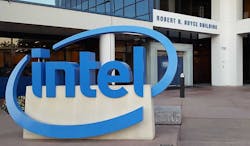This week Intel has taken a big step toward more powerful and customizable chips for servers, shipping a module that integrates its latest Xeon E5 processors with programmable chips acquired in its $16 billion deal for Altera. Combining the technologies will provide broader access to CPU acceleration techniques that have been common in high performance computing (HPC) and are making their way into the hyperscale computing ecosystem.
The new chip combines traditional Intel CPUs with field programmable gate arrays (FPGAs), semiconductors that can be reprogrammed to perform specialized computing tasks. FPGAs allow users to tailor compute power to specific workloads or applications.
Intel sees FPGAs as the key to designing a new generation of products to address emerging customer workloads in the data center sector, as well as the Internet of Things (IoT). FPGAs can serve as coprocessors to accelerate CPU workloads, an approach that is used in supercomputing and HPC, usually by teaming CPUs with NVIDIA GPUs or Intel’s x86-based Xeon Phi coprocessors. Altera was also a leading player in programmable logic devices (PLDs), which are widely used to automate industrial infrastructure.
Focus on Mega Data Centers
At the Intel Developers Forum Wednesday in Shenzhen, China, Intel executive Diane Bryant confirmed that Intel has begun a pilot program shipping development modules that package CPUs and Altera Arria 10 FPGAs, the first step on a roadmap that envisions an eventual single-chip integration. The new chipset is being shipped to existing customers for testing and development.
Diane Bryant, senior vice president and general manager of Intel’s Data Center Group, speaks Wednesday at the Intel Developers Forum in Shenzhen, China. (Photo:Intel)
The integration of FPGAs is a key strategy for Intel as it sharpens its focus on chips for large data centers. This is driven by the shift to cloud computing, which has shifted buying power from enterprises to large cloud computing platforms. Cloud infrastructure accounted for 32 percent of IT infrastructure products in the fourth quarter of 2015, according to IDC, up 4 percentage points from a year earlier. Meanwhile, revenue from equipment sales to traditional enterprises declined by 2.7 percent.
Intel expects this trend to continue. “Seventy to 80 percent of systems will be deployed in large-scale data centers by 2025,” said Jason Waxman, vice president of the Data Center and Cloud Platforms Group at Intel.
Hyperscale data center operators are seeking to optimize their infrastructures, and FPGAs offer more sophisticated processing architectures that can bring HPC-style parallel processing of workloads.
“We think FPGAs are very strategic,” said Raejeanne Skillern, GM of the Cloud Service Provider Business at Intel. “A lot of the use cases fall into cloud, but also the Internet of Things. There are a lot of workloads where you have the ability to save cores and offload work.
“We’re still at the beginning of the integration (with Altera),” she added. “We’re doing a lot of development with OEMs and customers, and continuing to implement (FPGAs) into our roadmap.”
FPGA acceleration can be used in computing tasks related to artificial intelligence, encryption and compression, as Intel outlined in this slide from the Altera deal announcement:
Slide: Intel
On the customer front, a particular focus is the “Super 7” group of cloud service providers that are driving hyperscale infrastructure innovation. This group includes Amazon, Facebook, Google and Microsoft, along with Chinese hyperscale companies Alibaba, Baidu and Tencent. At Intel’s investor meeting last November, Bryant said that four of the seven companies are expected to sample the new CPU/FPGA products.
Courting the Open Compute Crowd
That’s why Intel was a prominent presence at last month’s Open Compute Summit, where it noted that Facebook is an early development partner. Facebook recently worked closely with Intel to retool its server form factor, shifting from its traditional two-processor server to a system-on-chip (SoC) based on a single Xeon-D processor that uses less power and solves several architectural challenges. The new architecture also allows for the integration of coprocessors.
“We wanted to build an infrastructure that consisted of a number of simple, modular building blocks, which would allow us to incorporate other compute logic (FPGAs or GPUs) in the future,” Facebook’s Vijay Rao and Edwin Smith wrote on the Facebook Engineering blog.
At the Open Compute Summit, Waxman said Intel is developing libraries to help developers create applications that can take advantage of the additional processing capabilities.
Dan McNamara, general manager of the new Programmable Solutions Group at Intel, said the group will “create market-leading programmable logic devices that deliver a wider range of capabilities than customers experience today … (enabling) customers to create the next generation of electronic systems with unmatched performance and power efficiency.”






